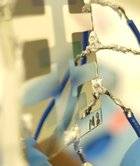
Research group
Functional materials
Information Optics Department
The progress in the development of optics in recent years can be considered as a real revolution. It happened thanks to technological development, which made it possible to study more and more subtle optical phenomena. The results of experiments often require verification of our existing knowledge.
The research carried out in our group corresponds with this trend and is related to the idea of nanostructured optical functional materials. It is a class of materials whose unique optical properties result from the nanostructure process and go beyond the material properties of the components used. We make most of such areas of knowledge as nanophotonics, plasmonics, and metamaterials. We work on computer modeling, fabrication, and characterization of nanostructures. We collaborate with foreign universities, including King's College London, Wigner Research Center for Physics (Hungarian Academy of Sciences), and Sapienza Università di Roma.
Currently, our research focus is:
- Memristor structures for neuromorphic operations in AI systems
- Intelligent materials for heating or cooling to temperatures different from the surroundings without additional power supply
- Designing dispersion and nonlinear properties of next-generation optical elements
- Ultrafast light modulation
- Generation of hot electrons for renewable energy applications
Research project
-
Smart passive materials capable of heating or cooling to temperatures different than ambient without additional power supply
Source of financing: NCN, SONATA BIS
Realisation period: April 7, 2023–April 6, 2027 -
Elektrycznie modulowane zjawiska optyczne w metaliczno-dielektryczno-półprzewodnikowym metamateriale wielowarstwowym
Source of financing: NCN, SONATA
Realisation period: July 12, 2019–July 11, 2024
| dr Tomasz Stefaniuk |
| dr Patrycja Wytrych | |
| mgr Alexander Korneluk | |
| mgr Dominika Niewczas |
Associates
Katarzyna Brańko
Urszula Malecka
Jan Jarzyna
| mgr Arkadiusz Ciesielski |
